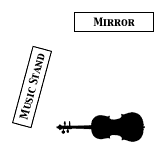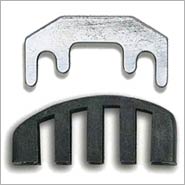Practice Makes Better
When setting up to practice, it's important that the top of your music be level with your eyes. when purchasing a music stand, make sure that it goes up high enough to accomplish this, it'll help you in not straining or going out of position just to read music. Also, a full-length mirror is very helpful in giving you feedback on your arm positions, violin level, finger positions and bow movement. Note the angle between the music stand and mirror, and that the violin is more or less parallel with the mirror. When practicing, in general, point the scroll of the violin at the left edge of your music.

Practice Mutes
About practicing in an apartment building: paper thin walls and neighbors that make Godzilla look like Barney.... If you're finding that you're encountering problems practicing, or that the only time you have to practice is late at night, you may wish to purchase a "practice mute". Though it's not recommended to practice regularly with a mute, a practice mute may be the only solution in tight quarters when surrounded by neighbors who may be, perhaps, striving to become better supporters of the arts.
Practice mutes are made of thick, heavy rubber or metal and slip on the bridge deadening the sound of the instrument greatly. There are two types of mutes, a performance mute and a practice mute, the performance mute only softens the sound a little bit, so make sure you don't accidentally purchase that one if volume is truly a concern.
When mounting the metal mute (in particular), do take care to hold your violin at a steep angle or upside down so that the mute does not accidentally fall straight onto the face of your instrument if it slips out of your control, it's very heavy and will damage your violin if dropped on it.


Setting Up Your Music Studio